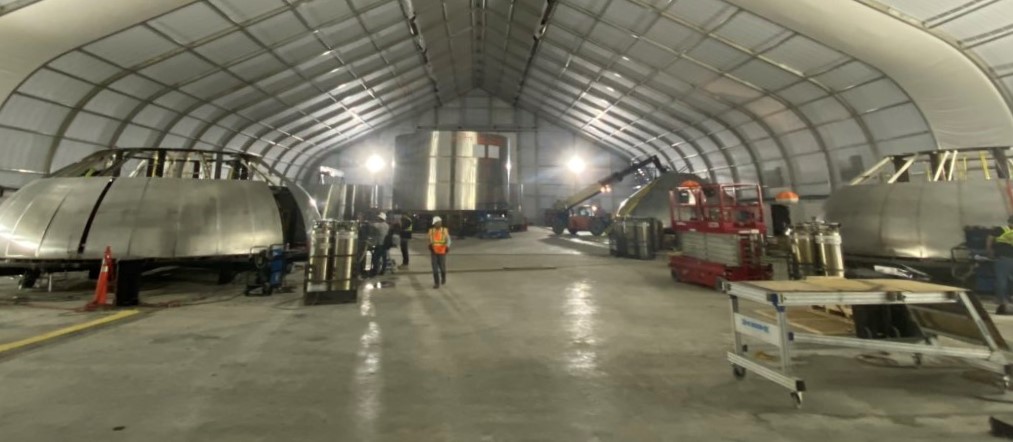

News
Elon Musk reveals SpaceX Starship production well underway inside new Texas factory
SpaceX CEO Elon Musk has offered a new glimpse inside the company’s rapidly-expanding South Texas Starship factory, revealing the beginnings of the next-generation rocket’s first true assembly line — and a wealth of spacecraft hardware.
Situated two or so miles from the Gulf of Mexico (and Mexico itself) in Boca Chica, Texas, SpaceX has been seriously planning a presence in South Texas for more than five years. Originally meant to host the United States’ first private orbital launch complex for Falcon 9 and Falcon Heavy rockets, only a small amount of work – known as soil surcharging – was done in the four years that followed SpaceX’s 2014 announcement. In late 2018, however, work began in earnest to build basic launch and manufacturing facilities.
Less than six months later, the first true Starship prototype – known as Starhopper and built from scratch out in the South Texas elements – ignited its Raptor engine for a brief static fire test, bringing the first to facilities and rocket to life less than half a year after they were little more than a pile of dirt and steel sheets. Now, barely nine months after Starhopper’s first static fire test, SpaceX is working around the clock to erect a full-scale rocket factory and build what could become the first orbital-class Starships. On February 9th, Elon Musk offered the best glimpse yet of the incredible progress SpaceX has made in a matter of weeks.
Barely a month ago, the rocket hardware pictured above did not exist, while the giant Tesla-inspired tent containing those Starship parts was a half-finished skeleton. Now, Elon Musk says that SpaceX has effectively completed three of the hardest parts of its first upgraded Starship prototype (SN01), while an additional two (of three) of those parts – known as propellant tank domes – are already in work for a second Starship (SN02).
Outside of the ‘sprung structure’ (i.e. tent) shown in Musk’s February 9th photo, SpaceX contractors appear to be just days away from completing the shell of a second identical tent, ultimately doubling the space available for enclosed manufacturing operations. At the same time as both Starship hardware and production facilities are rapidly coming together, SpaceX is also erecting what is presumed to be a Vehicle Assembly Building – a potentially massive structure that will protect vertical Starships and Super Heavy boosters from the elements while workers assemble them into finished rockets.

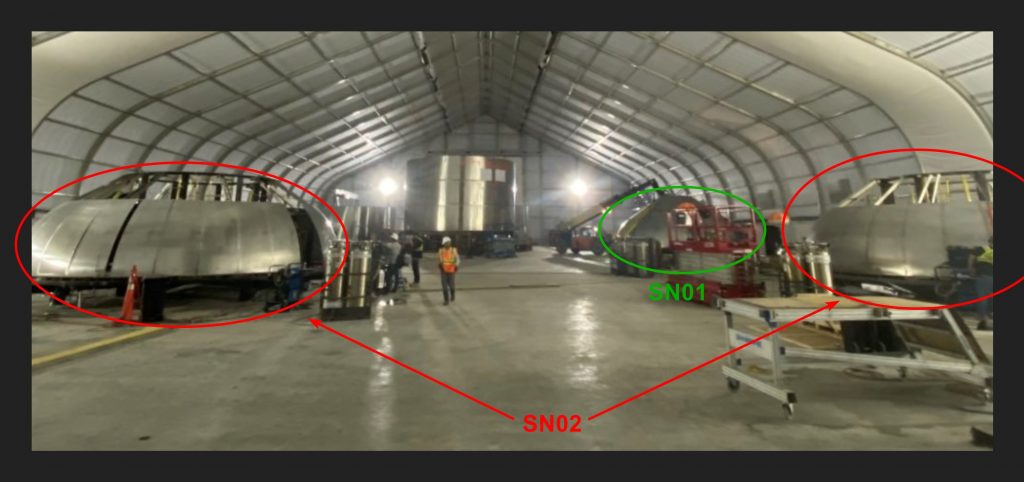
Inside the finished tent, SpaceX appears to have set up the first true Starship assembly line (of sorts), expanding from working on a single kind of prototype at a time to concurrent (serial) production of major components. Visible are three Starship bulkheads (tank domes) – two completed instances of which have already been transported outside and integrated with finished ring segments, forming two halves of Starship SN01’s complete liquid methane (LCH4) tank.
Near the back of the tent, work is also ongoing on several Starship SN01 tank rings. In the center, technicians are outfitting Starship SN01’s engine and ‘skirt’ section, where the bottommost tank dome will attach to three (up to six) Raptor engines. To the left, a stack of two rings appears to be stored off to the side, while – only slightly visible in Musk’s photo – another pair of rings is being welded together with the help of a rotating table.
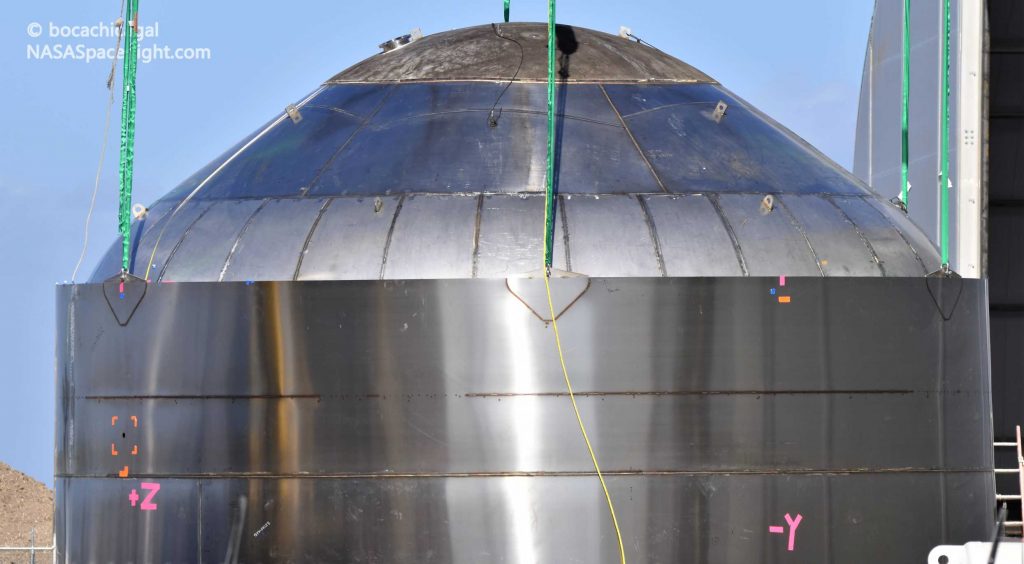

Far from its full capacity and working out of a much smaller tent, SpaceX’s dedicated ringforming station – tasked with turning coils of steel into finished Starship rings – has finished no less than 34 steel rings since the January 1st. SpaceX is still clearly learning and at least third of those rings wound up being scrapped due to defects, but the material cost of all of those rings (~55 tons of steel) is probably less than $150,000. Additionally, those 34 completed segments would reach more than 60 meters (200 ft) tall if stacked, enough to build almost two Starship tank and engine sections – domes excluded.
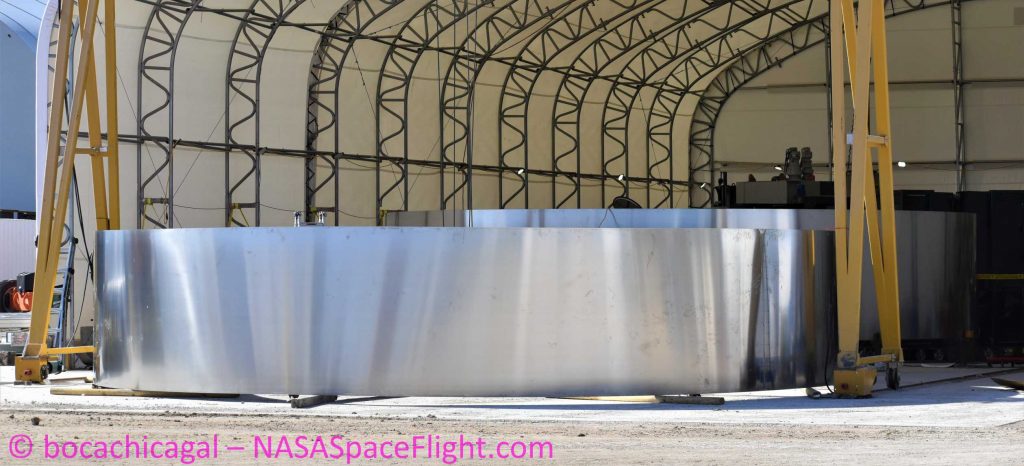
In simple terms, SpaceX has pivoted away from the more boutique style of prototype fabrication used for Starhopper and Starship Mk1 and is now building Starship SNxx hardware extremely quickly. At the same time, the enclosed manufacturing space available to SpaceX is probably going to double before this week is out. Ultimately, SpaceX’s March 2020 Starship SN01 flight debut target is quickly becoming less and less crazy by the day.
Check out Teslarati’s Marketplace! We offer Tesla accessories, including for the Tesla Cybertruck and Tesla Model 3.

Elon Musk
Tesla CEO Elon Musk says automakers do not want to license Full Self-Driving

Tesla CEO Elon Musk revealed today on the social media platform X that legacy automakers, such as Ford, General Motors, and Stellantis, do not want to license the company’s Full Self-Driving suite, at least not without a long list of their own terms.
“I’ve tried to warn them and even offered to license Tesla FSD, but they don’t want it! Crazy,” Musk said on X. “When legacy auto does occasionally reach out, they tepidly discuss implementing FSD for a tiny program in 5 years with unworkable requirements for Tesla, so pointless.”
I’ve tried to warn them and even offered to license Tesla FSD, but they don’t want it! Crazy …
When legacy auto does occasionally reach out, they tepidly discuss implementing FSD for a tiny program in 5 years with unworkable requirements for Tesla, so pointless. 🤷♂️
🦕 🦕
— Elon Musk (@elonmusk) November 24, 2025
Musk made the remark in response to a note we wrote about earlier today from Melius Research, in which analyst Rob Wertheimer said, “Our point is not that Tesla is at risk, it’s that everybody else is,” in terms of autonomy and self-driving development.
Wertheimer believes there are hundreds of billions of dollars in value headed toward Tesla’s way because of its prowess with FSD.
A few years ago, Musk first remarked that Tesla was in early talks with one legacy automaker regarding licensing Full Self-Driving for its vehicles. Tesla never confirmed which company it was, but given Musk’s ongoing talks with Ford CEO Jim Farley at the time, it seemed the Detroit-based automaker was the likely suspect.
Tesla’s Elon Musk reiterates FSD licensing offer for other automakers
Ford has been perhaps the most aggressive legacy automaker in terms of its EV efforts, but it recently scaled back its electric offensive due to profitability issues and weak demand. It simply was not making enough vehicles, nor selling the volume needed to turn a profit.
Musk truly believes that many of the companies that turn their backs on FSD now will suffer in the future, especially considering the increased chance it could be a parallel to what has happened with EV efforts for many of these companies.
Unfortunately, they got started too late and are now playing catch-up with Tesla, XPeng, BYD, and the other dominating forces in EVs across the globe.
News
Tesla backtracks on strange Nav feature after numerous complaints

Tesla is backtracking on a strange adjustment it made to its in-car Navigation feature after numerous complaints from owners convinced the company to make a change.
Tesla’s in-car Navigation is catered to its vehicles, as it routes Supercharging stops and preps your vehicle for charging with preconditioning. It is also very intuitive, and features other things like weather radar and a detailed map outlining points of interest.
However, a recent change to the Navigation by Tesla did not go unnoticed, and owners were really upset about it.
For trips that required multiple Supercharger stops, Tesla decided to implement a naming change, which did not show the city or state of each charging stop. Instead, it just showed the business where the Supercharger was located, giving many owners an unwelcome surprise.
However, Tesla’s Director of Supercharging, Max de Zegher, admitted the update was a “big mistake on our end,” and made a change that rolled out within 24 hours:
The naming change should have happened at once, instead of in 2 sequential steps. That was a big miss on our end. We do listen to the community and we do course-correct fast. The accelerated fix rolled out last night. The Tesla App is updated and most in-car touchscreens should…
— Max (@MdeZegher) November 20, 2025
The lack of a name for the city where a Supercharging stop would be made caused some confusion for owners in the short term. Some drivers argued that it was more difficult to make stops at some familiar locations that were special to them. Others were not too keen on not knowing where they were going to be along their trip.
Tesla was quick to scramble to resolve this issue, and it did a great job of rolling it out in an expedited manner, as de Zegher said that most in-car touch screens would notice the fix within one day of the change being rolled out.
Additionally, there will be even more improvements in December, as Tesla plans to show the common name/amenity below the site name as well, which will give people a better idea of what to expect when they arrive at a Supercharger.
News
Dutch regulator RDW confirms Tesla FSD February 2026 target
The regulator emphasized that safety, not public pressure, will decide whether FSD receives authorization for use in Europe.
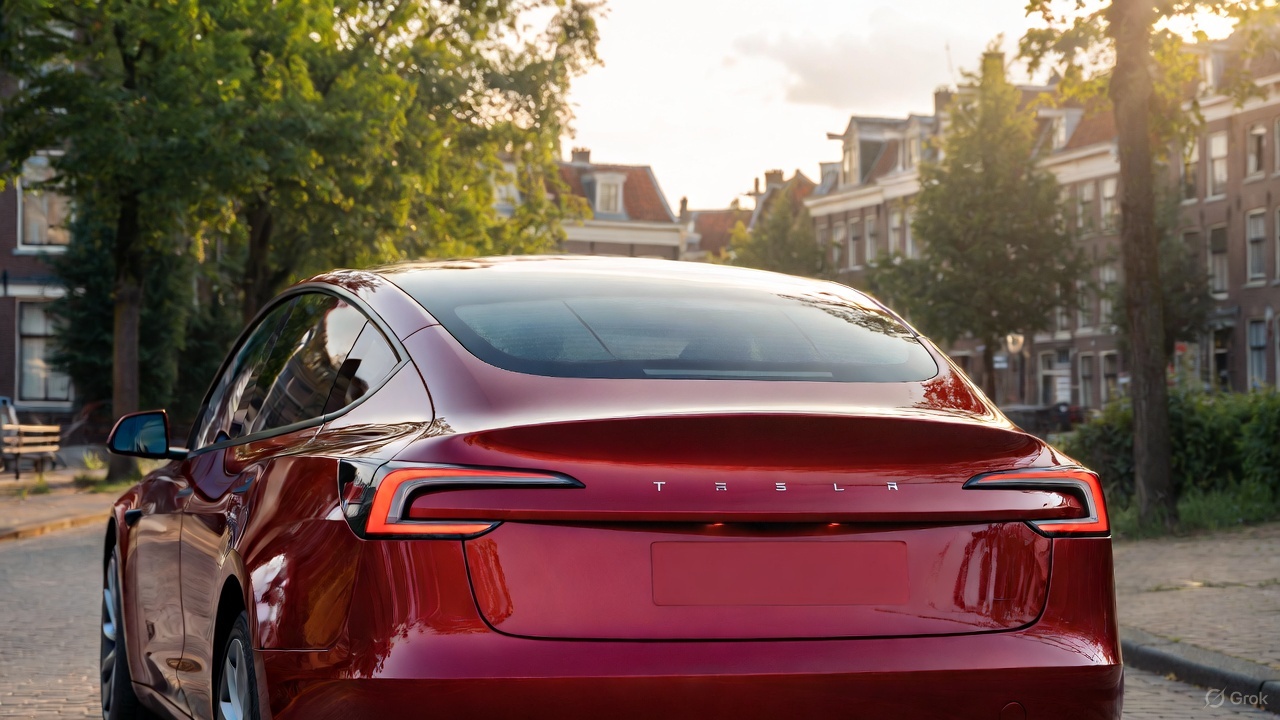
The Dutch vehicle authority RDW responded to Tesla’s recent updates about its efforts to bring Full Self-Driving (Supervised) in Europe, confirming that February 2026 remains the target month for Tesla to demonstrate regulatory compliance.
While acknowledging the tentative schedule with Tesla, the regulator emphasized that safety, not public pressure, will decide whether FSD receives authorization for use in Europe.
RDW confirms 2026 target, warns Feb 2026 timeline is not guaranteed
In its response, which was posted on its official website, the RDW clarified that it does not disclose details about ongoing manufacturer applications due to competitive sensitivity. However, the agency confirmed that both parties have agreed on a February 2026 window during which Tesla is expected to show that FSD (Supervised) can meet required safety and compliance standards. Whether Tesla can satisfy those conditions within the timeline “remains to be seen,” RDW added.
RDW also directly addressed Tesla’s social media request encouraging drivers to contact the regulator to express support. While thanking those who already reached out, RDW asked the public to stop contacting them, noting these messages burden customer-service resources and have no influence on the approval process.
“In the message on X, Tesla calls on Tesla drivers to thank the RDW and to express their enthusiasm about this planning to us by contacting us. We thank everyone who has already done so, and would like to ask everyone not to contact us about this. It takes up unnecessary time for our customer service. Moreover, this will have no influence on whether or not the planning is met,” the RDW wrote.
The RDW shares insights on EU approval requirements
The RDW further outlined how new technology enters the European market when no existing legislation directly covers it. Under EU Regulation 2018/858, a manufacturer may seek an exemption for unregulated features such as advanced driver assistance systems. The process requires a Member State, in this case the Netherlands, to submit a formal request to the European Commission on the manufacturer’s behalf.
Approval then moves to a committee vote. A majority in favor would grant EU-wide authorization, allowing the technology across all Member States. If the vote fails, the exemption is valid only within the Netherlands, and individual countries must decide whether to accept it independently.
Before any exemption request can be filed, Tesla must complete a comprehensive type-approval process with the RDW, including controlled on-road testing. Provided that FSD Supervised passes these regulatory evaluations, the exemption could be submitted for broader EU consideration.








